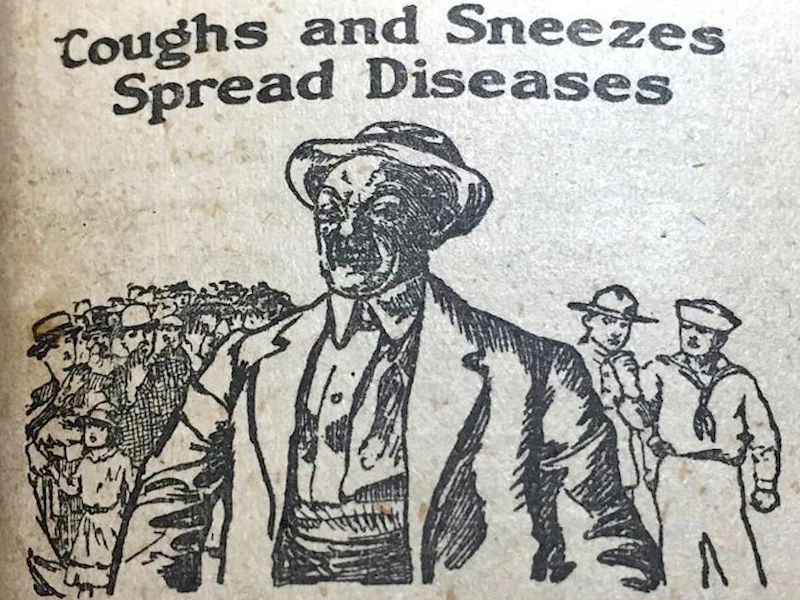How the Spanish Flu Epidemic Affected Daily Life in Danville, VA
Imagine, if you will, those close to you suddenly and horribly sickening, and often dying. There is no television to inform you. In fact, the first radio news broadcast would not occur for another two years. You depend solely on your local newspaper, conversation (rumors?) & broadsides on the street corner, and letters from friends and loved ones.
The year is 1918, and one of the deadliest natural disasters in human history is taking hold. Most deaths occurred in a sixteen-week period, from mid-September to mid-December of 1918. By the end, it is estimated that between 50 and 100 million perished world-wide. In the United States alone, approximately 675,000 succumbed.
Many of us have heard or read about the flu epidemic of 1918, but there are few still alive who “remember” the event. From eBay, I recently purchased a letter written on December 22, 1918 in Danville (the “story” behind the letter appears on the next page). Comments, about dealing with her children and the flu, made by the letter writer to her brother stationed in Europe, piqued my interest. How did the flu epidemic dictate life-changes in 1918 Danville? How would I go about investigating such a local phenomenon, since it occurred almost 100 years ago? How many Danvillians died?
A Google search yielded almost nothing of a truly “local” nature. And since the Danville newspapers available through my subscription to newspapers.com do not begin until 1922, the Internet was looking like a dead end. When in doubt, ask a librarian. Thanks to the resources of the Danville Public Library, I was able to spend hours spinning through the microfilm of the Danville Register (1918), looking for news articles and human interest stories that would tell the tale of life in Danville during the deadly flu outbreak.
One of the earliest reports of the “flu” found in the Danville Register was datelined August 11, 1918, originating from the Newspaper Enterprise Association. Although buried on page 5, of necessity because the front pages during this time were almost completely devoted to covering the final months of WWI, still the story details six hundred deaths in London since June, German armies quarantined in French and Belgium “flu camps” to prevent a spread throughout the “Hun” armies, and the hardest hit in Austria, where thousands died while also battling cholera and malnutrition.
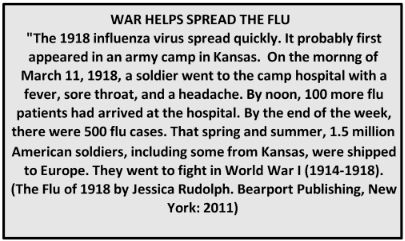
Beginning on September 14, 1918 (and for the next two weeks), the Register promoted to the front page stories headlined “Sharp Outbreak of Spanish Influenza in United States,” “Spanish Flu Raging at Camps Throughout Land,” and “Spanish Flu Is Fast Spreading Over Land From Atlantic to Pacific shore.” By now, reporters and government officials had added the word PANDEMIC to their flu lexicon. Surgeon General Blue detailed the spread of the disease to US army camps (29,000 cases), related a tale of a tramp steamer arriving in in Newport News with the entire crew stricken, and interestingly postulated that, since the last flu epidemic occurred in 1892, doctors beginning practice since then would need to be brought up to speed on diagnosis and treatment. Dr. Blue issued a special bulletin through the Associated Press, directed at ALL medical personnel. Additionally, Congress appropriated one million dollars to produce and distribute a newly discovered serum.
NOT SERIOUS:
“The scare is all in the name, Spanish influenza” was how Dr. R.B. James of the Danville Board of Health characterized the situation on October 2, 1918. “No cause for fear.” His strongly worded statement dismissed the alarm over what he claimed was just a “severe cold” or the “grip,” and characterized calls for the closing of schools as “absurd.” The best precaution—“avoid sudden temperature changes and sit on the porch these cool evenings.” He concluded by noting that neither Averett nor Stratford had a single case of the flu. However, Chatham schools had been closed for a week. Three days later, the Virginia State Board of Health affirmed this guarded optimism by voting NOT to order schools or county fairs closed. Interestingly, at the same time the Board “contented itself” by recommending that regulations be read at schools weekly and published in newspapers daily. Recommendations such as: avoid pool rooms and moving picture shows—do not attend church or Sunday school—do not share drinking or communion cups—do not frequent railroad depots, boat landings, waiting rooms, hotel lobbies or stores. Then, on October 8th, the Danville Register reported (front page) “Danville’s Fair Declared Off and Public Schools, Picture Shows and Churches Closed” by order of the State Health Board. Locally, “all large public gatherings for any purpose” were forbidden. Conditions in neighboring towns were “alarming.” Roxboro made a plea to Danville, being “without a physician and in urgent need of one or more.” Already in Roxboro, five had died. Between October 8th and the 11th, the number of flu cases in Danville rose from 408 to 684. The tide had shifted.
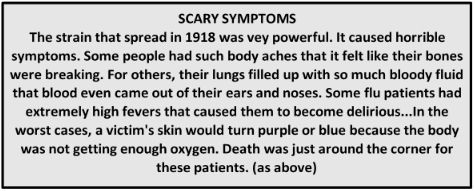
BUSINESSES:
The first and one of the most noteworthy events to affect Danville business and culture was the cancellation of the annual Fair. However, of much greater economic impact was the shuttering of Danville’s bright leaf tobacco market on after Wednesday October 16th, “as a precaution against the spread of Spanish influenza to contigious (sic) rural sections marketing their crop here.” This action was repeated throughout Virginia and North Carolina. On Saturday the 19th, the Danville Board of Health ordered “every store, barbershop and every business that usually is crowded on that day, to close their doors at 4 o’clock…and keep them closed until the following Monday.” The Board continued: “There is no exception to this ruling, if in your place crowds congregate on this day, then the ruling concerns you, and disobeyance (sic) of the board’s order means that you will be summoned before the Mayor and fined.” Statistics released to date included over 1200 cases of the flu, but with only ten deaths. The reporter observed “while there is no question that the situation here is grave…the fatalities have not been as great as in other cities.” Adding: “ … it behoves (sic) every good citizen to lend their aid. Householders are requested to get their orders for groceries … in early to the merchant.” During the three-month span, October through December, the severity of (and anxiety over) the flu and sentiment concerning the closing of public and business gatherings would rise and fall, reflecting the ever-vacillating stance taken by the local newspaper. On October 21st, “240 new cases…were discovered.” A quick reaction was for the “Dan River Cotton Mill Company, on the outskirts of the City (Schoolfield) to announce that it had established a hospital in one of the largest buildings.” Three days later, the headline declared “Influenza Waning Fast in Danville—To Rescind Closing.” November 17th: “FEW CASES OF INFLUENZA. Rumors that the influenza had returned here were flying right and left all day.” December 11th: “BOARD OF HEALTH NOT TO CLOSE UP TOWN ON ACCOUNT OF FLU…it was decided unanimously, that to put the lid on again here now, would not be to the best interests of Danville, whether viewed from a health or business standpoint.” On December 13th: “FLU REAPPEARS AT DANVILLE … 174 cases reported in the last two days (more cases than ever)…Board of Health considering closing down all public places…serious financial lose among merchants… Christmas shopping season…cheesecloth masks are being worn on the streets.” And that same day: “56 cases at Randolph-Macon Institute (later, Stratford College) … six trained nurses arrived here from Lynchburg to nurse the ailing scholars.” And finally, On December 14th, this story appeared (Greensboro Daily News): “Influenza continues to reap a grim toll in Danville. A particularly sad episode was witnessed yesterday afternoon at the home of Mr. and Mrs. Robert Taylor on Stokes Street, when at 4 o’clock their five-year-old daughter, Janie Taylor, passed away, followed four hours later by their eight-year-old son, Roland Taylor. Both were taken with the insidious malady…pneumonia developing in each case.”
PREVENTION:
Preventing the spread of the flu combined common sense with snake oil. As has been mentioned, a “drastic order was issued to the Danville Traction and Power company to ventilate its (trolley) cars by opening and keeping open the windows (October 12th).” While “INFLUENZA MASKS ONLY KNOWN SAFETY AGAINST INFECTION” was an initial preventative measure, the Danville Register published the following SIMPLE HEALTH RULES:
- Sleep with windows wide open, and have windows open in homes and offices during the day.
- Spray nose and gargle throat before each meal and upon retiring.
- Avoid crowded cars and crowds of all kinds.
- Drink plenty of water from clean glass.
- Keep liver active and bowels open.
- Cough and sneeze into handkerchief.
- Do not spit on sidewalk of any public place.
- Keep cool when walking, warm when riding, sitting, and sleeping.
- Wear influenza mask of cotton gauze when brought into contact with the disease.
An October 20th editorial warned “BEWARE OF INFLUENZA NOSTRUMS.” While citing measures similar to those above, “nostrums” was a reference to: eating onions with every meal—salt placed in the nostrils—smoke from sulfur, brown sugar or hot coals—smoking cigarettes—West’s “Electricity in a Bottle– Dr. Pierce’s Pleasant Pills–Foley’s Honey and Tar.
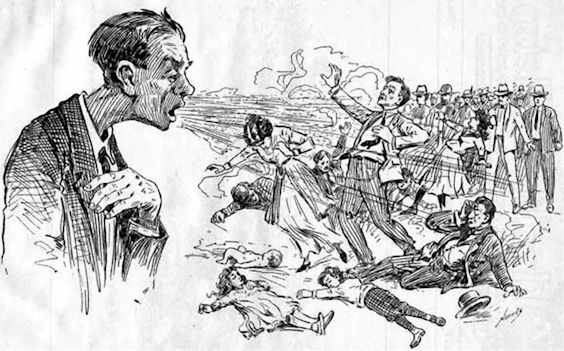
CARE:
Acting on instructions from the Potomac Division of the American Red Cross, a Danville Volunteer Nursing Corps was mobilized on October 8th “to combat the present epidemic of influenza.” A meeting of volunteers, including under-graduate nurses, practical nurses, nurses’ aides, school teachers, and housekeepers took place at the Y.M.C.A.. The agenda discussed a “plan of work,” hours, uniforms, and other details. The “plan” laid out a sequence of care: a physician calls the Red Cross to report a case of the flu–the Executive Secretary visits the patient—when “circumstances and surroundings justify it, a volunteer will be put on the case”—volunteers act according to the physician’s instructions. An interesting sidelight to the women’s’ volunteer movement involved the rail yard “canteen service” that provided passing soldiers with supplies and medical assistance. The newspaper reported that “some persons have suggested” that the practice of “meeting all trains from every quarter” might in fact be helping to spread the flu. Described as an “interesting phase of the local development of influenza” was the observation by a local physician (attested to by a “well-known colored citizen”) “that there were few, if any, cases reported among the colored people…Just why this comparative immunity of the race from the disease exists is not explained, nor even attempted.” On October 19th, the “keys to the Danville Military Institute” were turned over to the City health officer, and preparations were quickly made to equip the new “hospital” to accommodate 100 patients. Termed a “Godsend” and a “new haven of refuge,” the building was well-suited to such care. “Each room is equipped with hot and cold water…the boy’s mess hall will be used as the dormitory for the nurses.” Three days later, the new hospital was reported “running in full blast, ready, willing, and anxious to render services to rich or poor, high or low, white or colored.” Thirty-five of the “best women in Danville” had “scrubbed floors on their knees.” Men were not “lagging far behind in their zeal,” although their tasks were not enumerated. Lacking only sufficient blankets and someone to drive the ambulance, still the “emergency hospital (was) the one bright ray among the darkening clouds.” This particular article squarely acknowledged the peril facing Danville: “dreadful disease that is rapidly gaining headway–a foe who is a no respecter of persons–deadly menace rapidly gaining ground–relentless warfare–worse (sic) is yet to come–rapidly but surely getting more malignant.” And finally, “enough sacrificing men and women in Danville to insure us ample force to conduct this fight as it should be.”
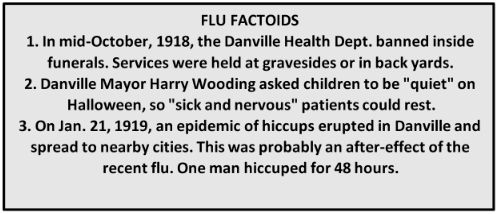
During the last two weeks of December 1918, Danville endured yet another wave of illness: “82 cases Tuesday Against 191 Cases the Day Before—the mortality is quite high among children of tender years.” The Emergency Influenza Hospital (DMI) was reopened, and all public schools were closed until the New Year. One citizen who “is usually well posted on local conditions asserted” that in total, there had been approximately 1800 cases in all stages of the disease. Dr. Garnett, the City Health Officer put out an urgent call for everyone, “trained or untrained,” to register as volunteer nurses. Vehicles were needed, and even the Boy Scouts were asked to register for service. Danville was preparing to wage war again. By the summer of 1919, however, the Spanish flu had gradually declined and finally came to an end. Those who were infected either developed immunity or died. According to a 2002 University of Richmond report, “The Impact of the 1918-1919 Influenza Epidemic on Virginia,” The City of Danville alone recorded 500 deaths in 1918, 137 (27%) due to the flu or related pneumonia.
Thanks to author David Corp and the Danville Historical Society.
Reference: The Flu of 1918 by Jessica Rudolph. Bearport Publishing, New York: 2011. The origin of the 1918 flu is variously reported as Kansas, France, and most recently Chinese laborers working behind the British and French battle lines. It is often referred to as the “Spanish” flu, but not because it originated in Spain or because Spaniards were especially hard hit. Wartime censors minimized reports of the illness in Europe and the US. Spain, however, was neutral in the war and therefore free to report on the spread of the flu.
